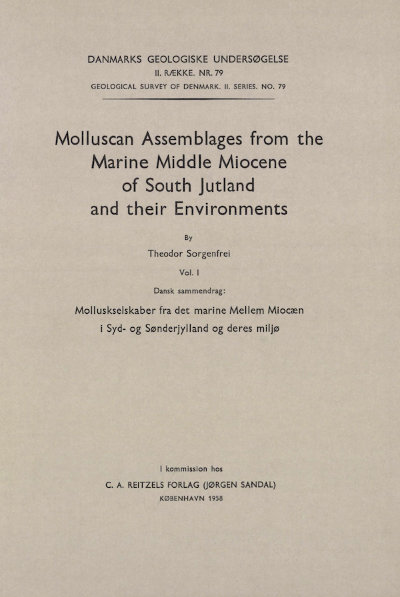Molluscan Assemblages from the Marine Middle Miocene of South Jutland and their Environments. Vol. I.
DOI:
https://doi.org/10.34194/raekke2.v79.6868Abstract
This is a study of the fossil record of marine Miocene beds in South Jutland, Denmark. The beds have been defined as the Arnum formation and referred to the middle Miocene Hemmoor stage as known in Northwest Germany. The object of the work is to increase knowledge of the Danish Miocene and to contribute data on the development of the North Sea Basin during Miocene time.
The introduction deals with the history of Tertiary stratigraphy in Europe and some related problems. Discrepancies and uncertainties regarding the correlation and dating of beds in the separate basins have been particularly emphasized. It is often possible to trace disagreements to the acceptance of unsound fossil evidence. Therefore it is concluded that the lithologic and fossil records of the individual basins should be known in much greater detail before adequate inferences as to the contemporaneity of particular beds can be made. It is also suggested that guide fossils should only be designated when statistically justified.
The chapters on the South Jutland Miocene contain an outline of the geo-graphic distribution of the formations, a lithologic description of the water well sections from which the fossil material was derived, and definitions of the Arnum formation (marine) and the underlying Ribe formation (non-marine). The following formations are now recognized in the Miocene sequence of South Jutland:
Gram formation: late MioceneArnum formation and Ribe formation: middle Miocene
Klintinghoved formation: early Miocene.
The chapters on paleontology consist of a description of the molluscan fauna of the Arnum formation, a discussion of the environmental relationships of recent mollusca, and a section on biostratigraphy and paleobiology.
The description of species follows a rigid pattern. The intention being to include as many pertinent facts as possible while using a minimum of technical terms. The variation of shell properties is illustrated by diagrams in a few species, and in some families genetic features have been particularly discussed. The chapter is terminated by a short review and some conclusions regarding the significance of shell morphology.
The chapter on environmental relationships of recent mollusca includes discussion of the effects of inanimate environments on shell morphology and the distribution of mollusca. It is maintained that the reaction of recent mollusca to variations in their environment should be known in greater detail in order to provide a sound basis for biostratigraphic conclusions depending on the evidence of fossil mollusca.
A discussion of the commonly adopted correlation procedures initiates the chapters dealing with biostratigraphy and paleobiology. It is shown that the "percentage" method by which faunas are correlated on the basis of percentages of species in common should be regarded with much criticism. New correlation formulae, in which are included the total numbers of species in the faunas involved are suggested. It is shown by these formulae and other evidence that the fauna of the Arnum formation in its entirety is apparently in better agreement with the Reinbek and Hemmoor faunas of Germany than with any other fauna of the North Sea Basin.
The paleobiological analysis of the fauna of the Arnum formation is based on: the biology of living species; the actual frequencies of the mollusca in the different drilled sections; and the environmental relationships of recent mollusca. It is inferred that a decrease in salinity took place during deposition of the formation. The faunules of the different fossiliferous levels are shown to be derivatives of one community: the Aporrhais alata - Nassa sp.sp. community which inhabited relatively shallow waters of the middle Miocene North Sea Basin.
In conclusion some comments are made on the correlation of the well sections as supported by paleobiology. The Nassa cimbrica and N. Fuchsi zones are defined, and the different elevations of correlated levels in the drilled sections are related to structural displacements.
Downloads
Published
Issue
Section
License
This article is distributed under a CC-BY 4.0 licence, permitting free redistribution and reproduction for any purpose, even commercial, provided proper citation of the original work. Author(s) retain copyright over the article contents.


